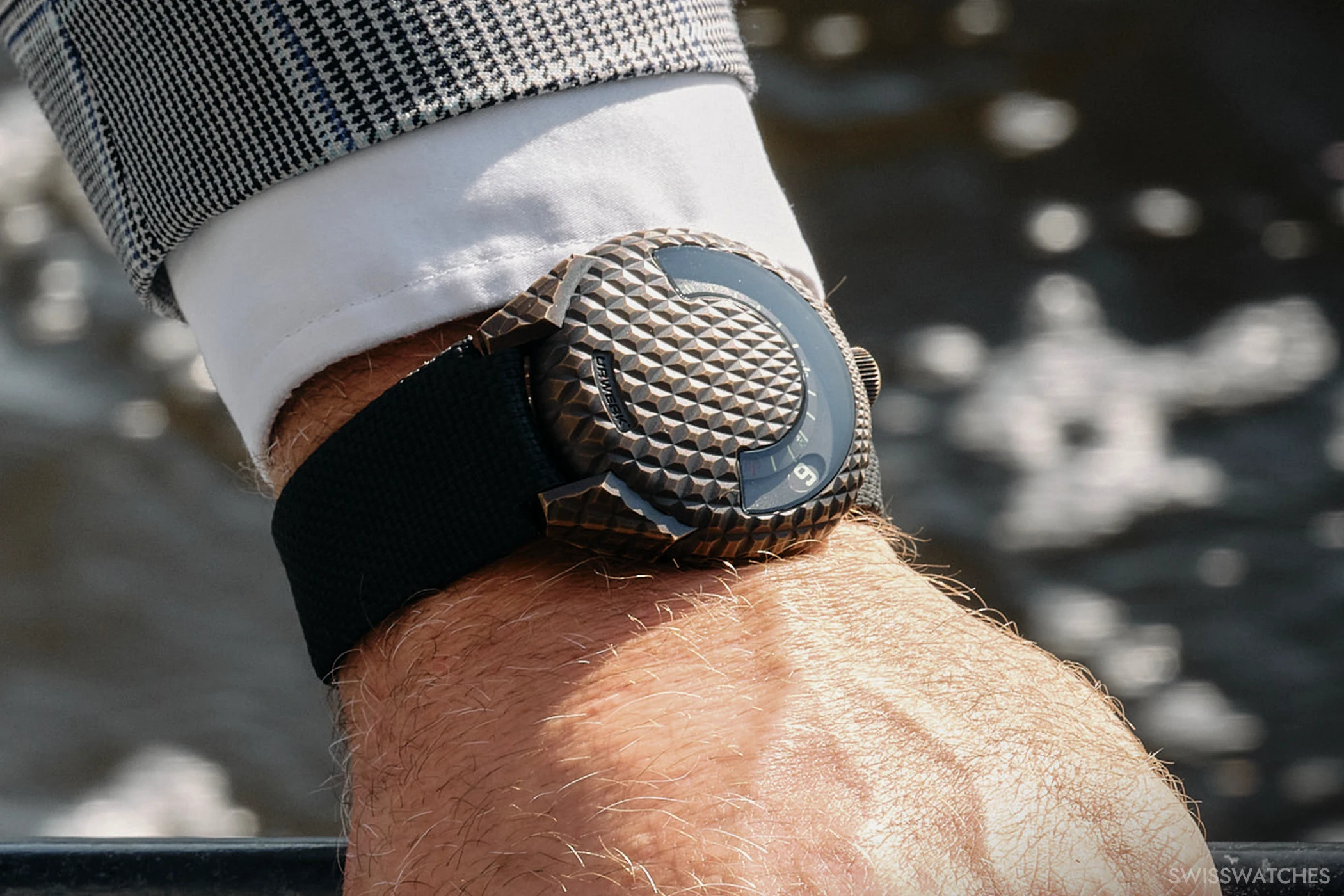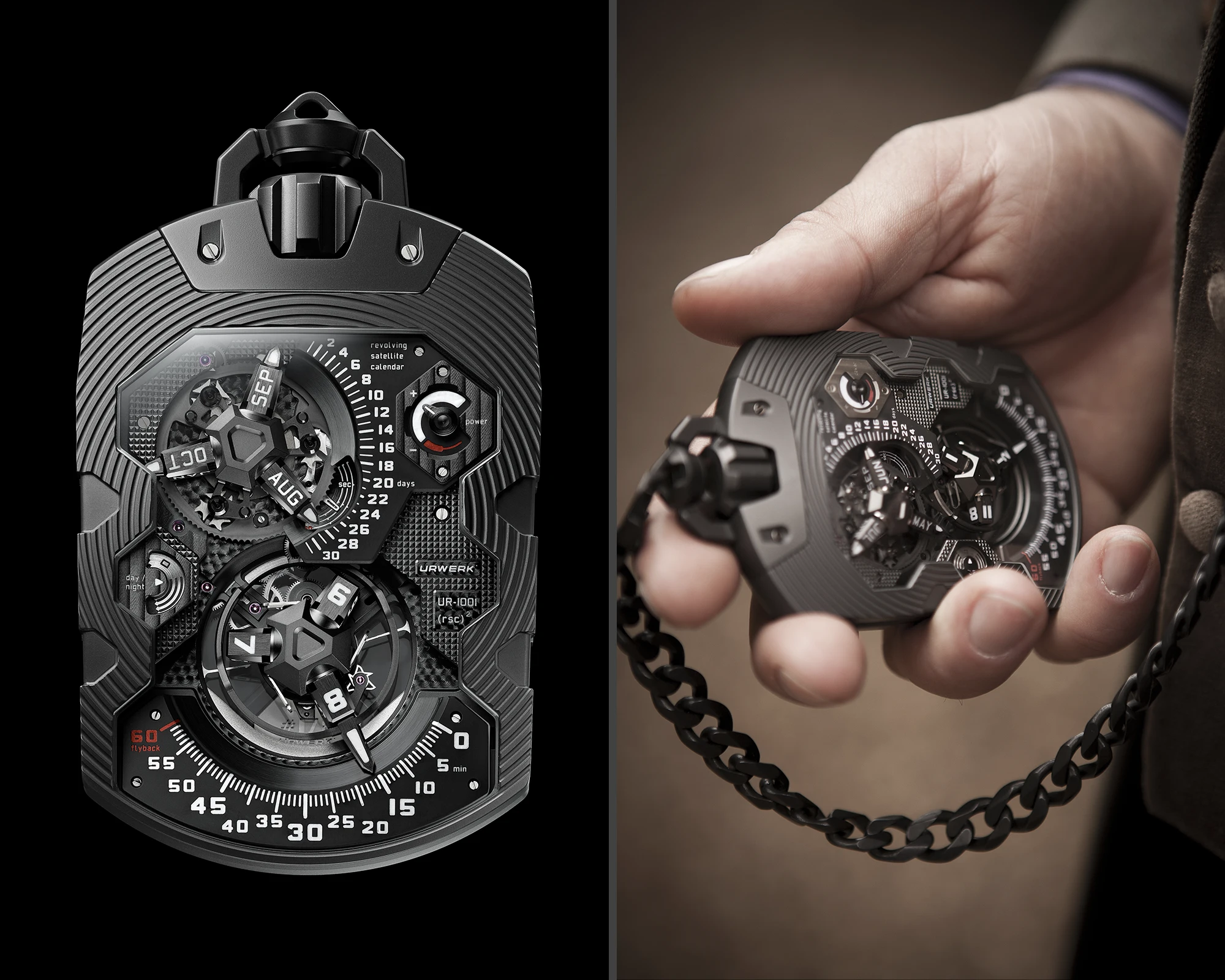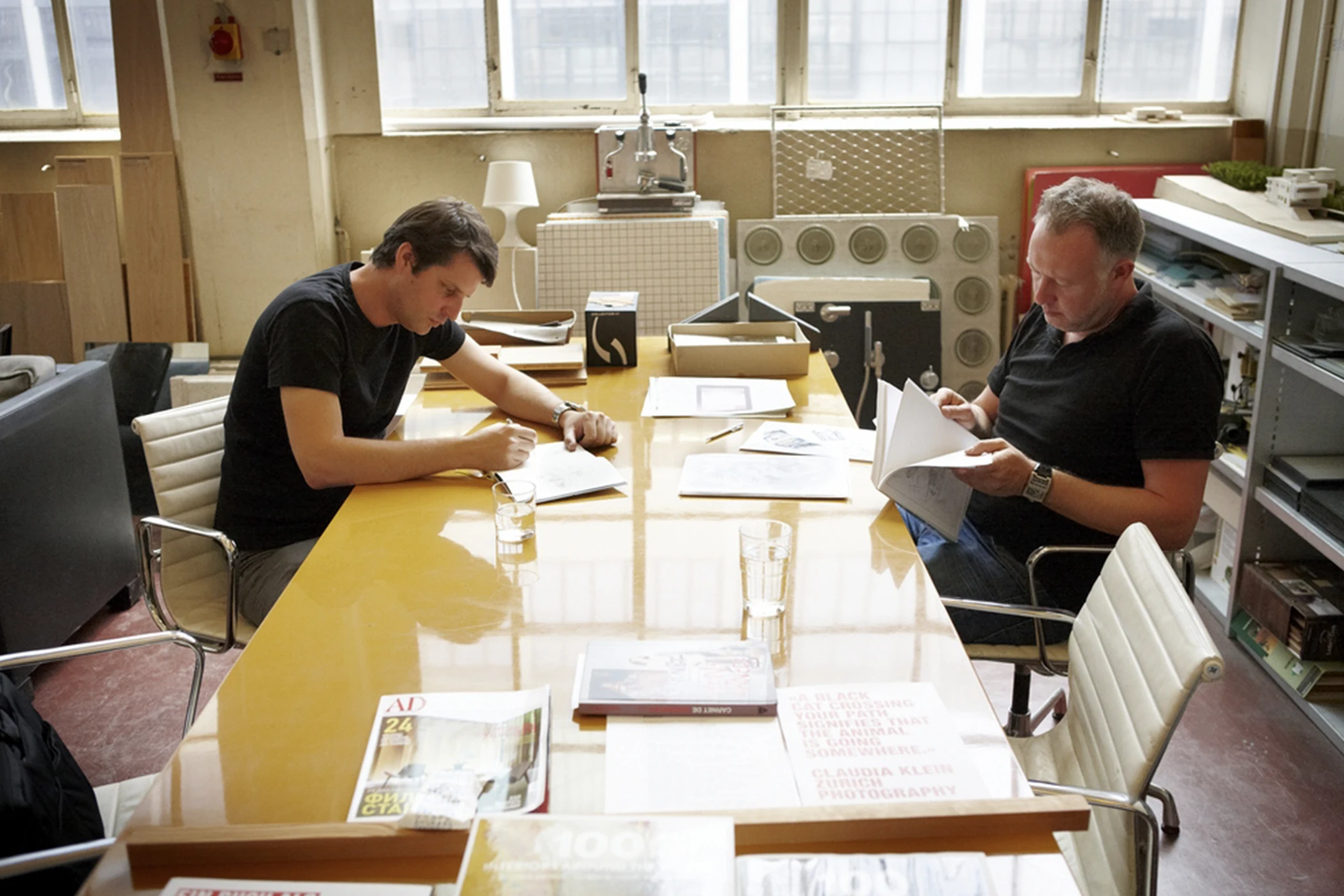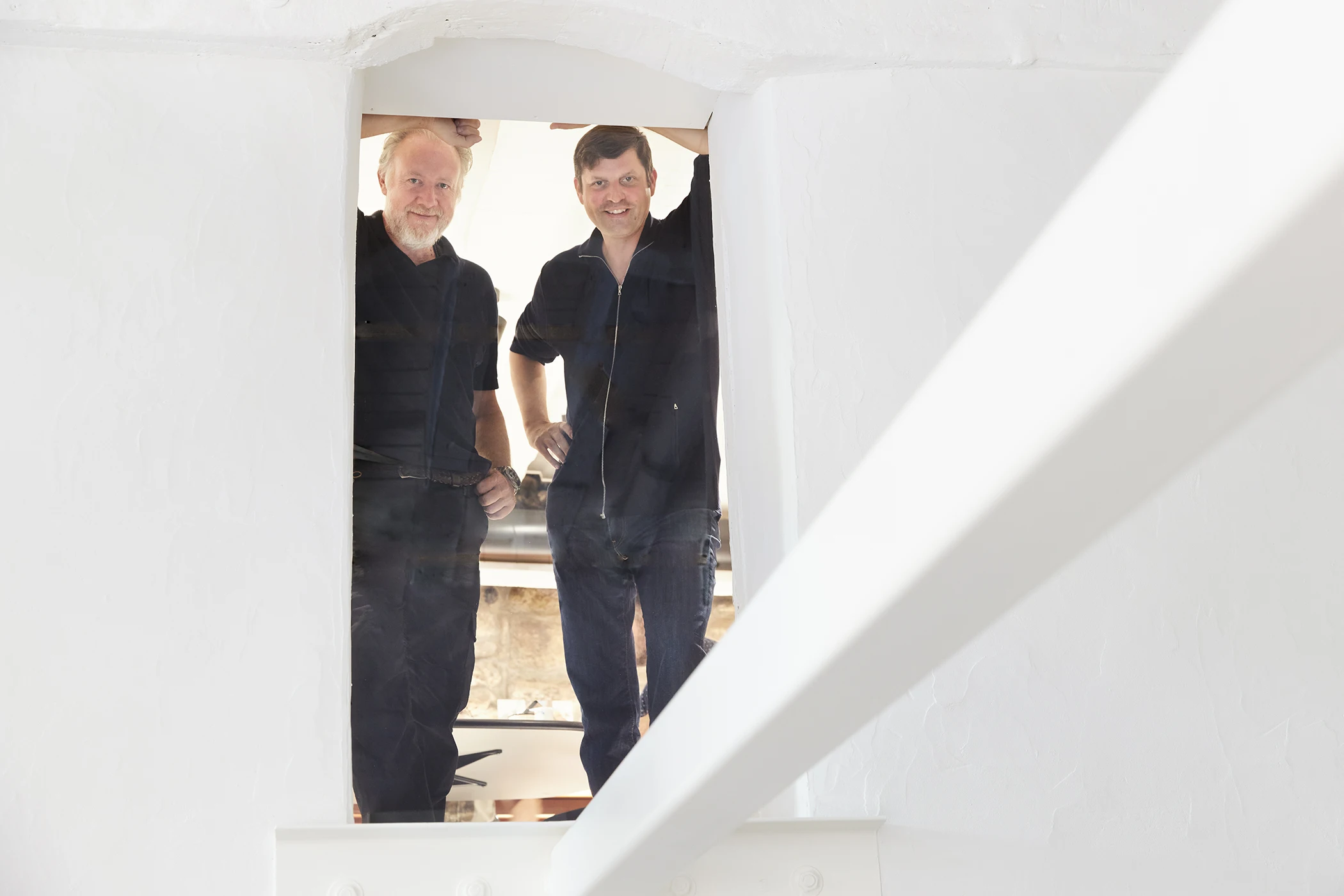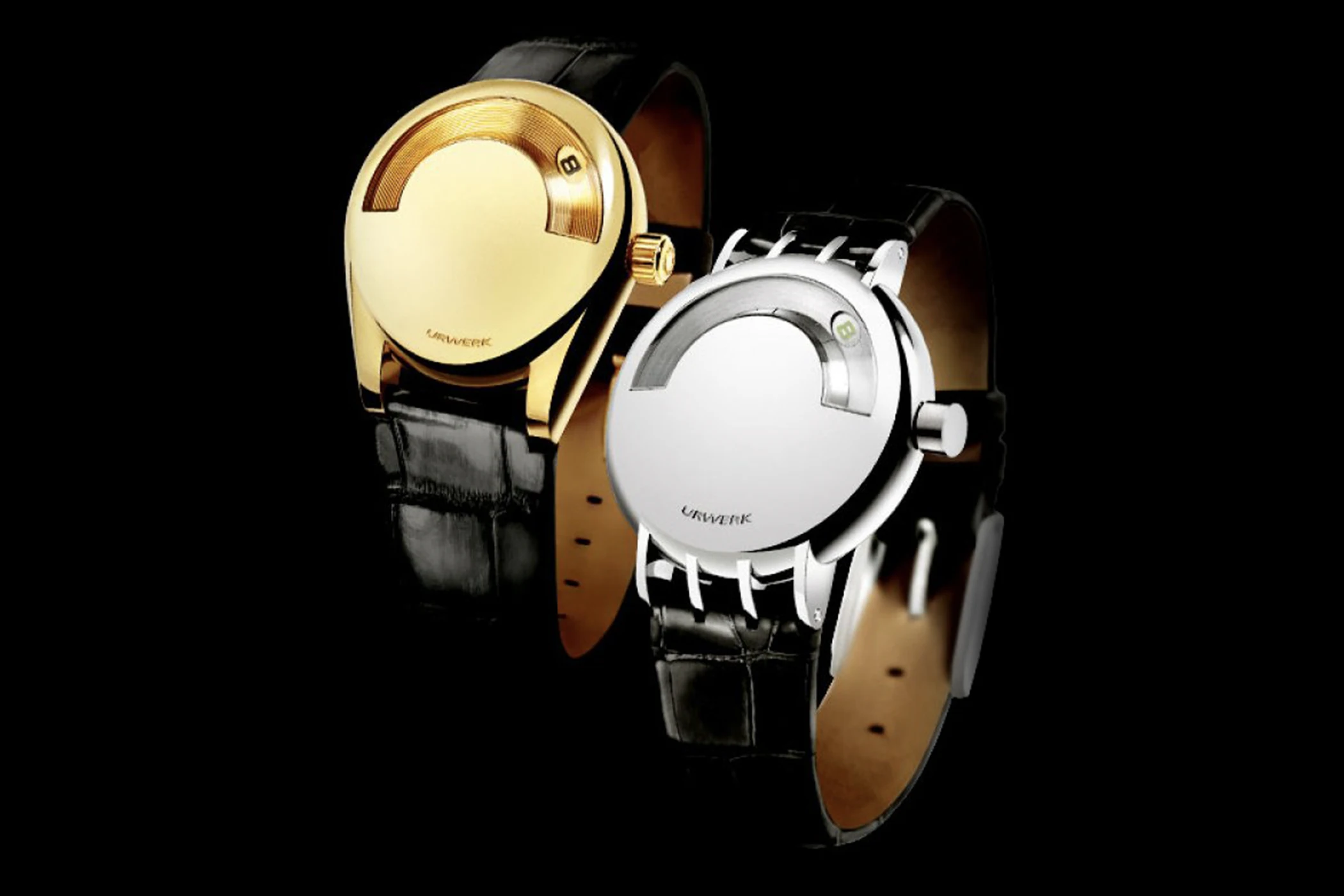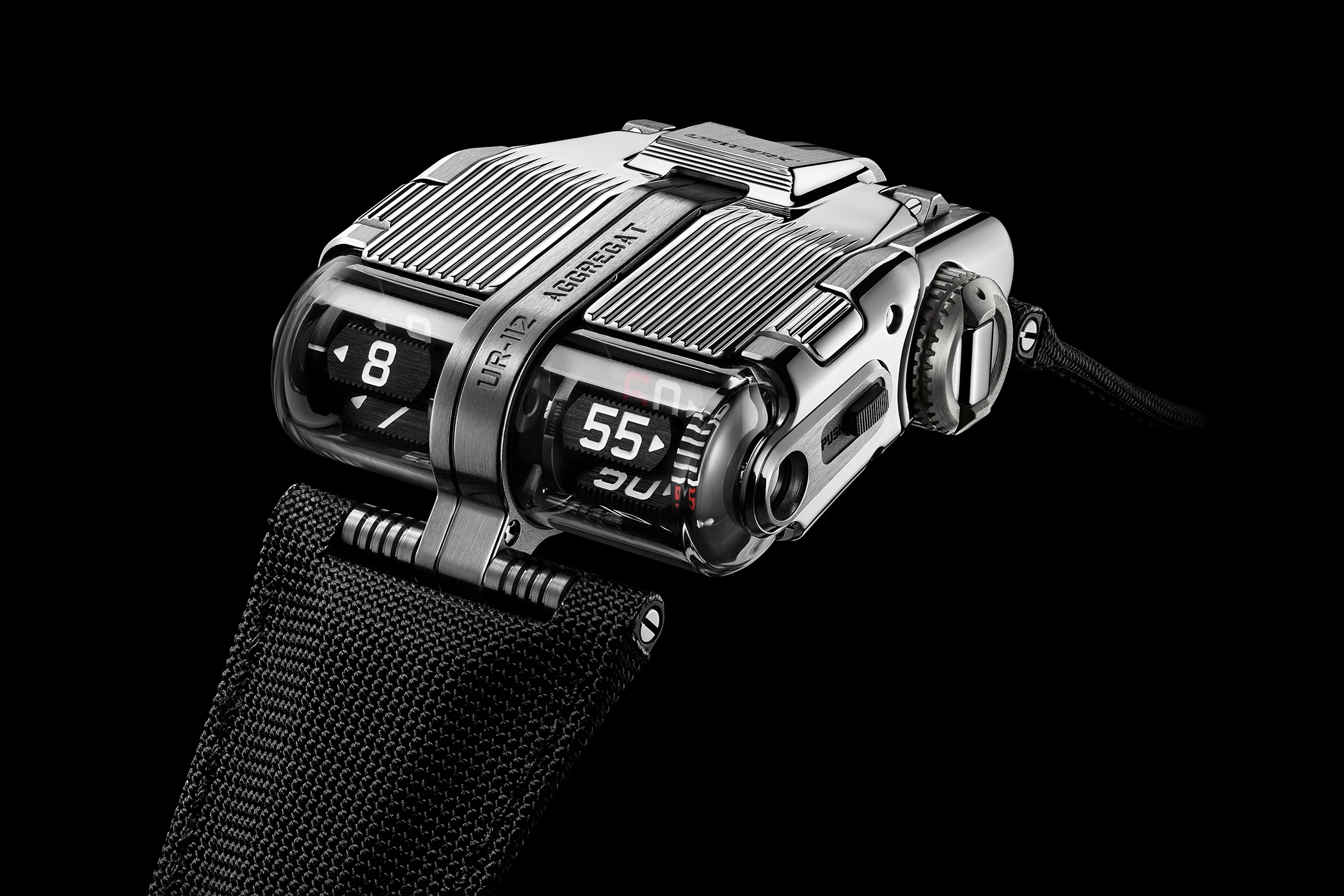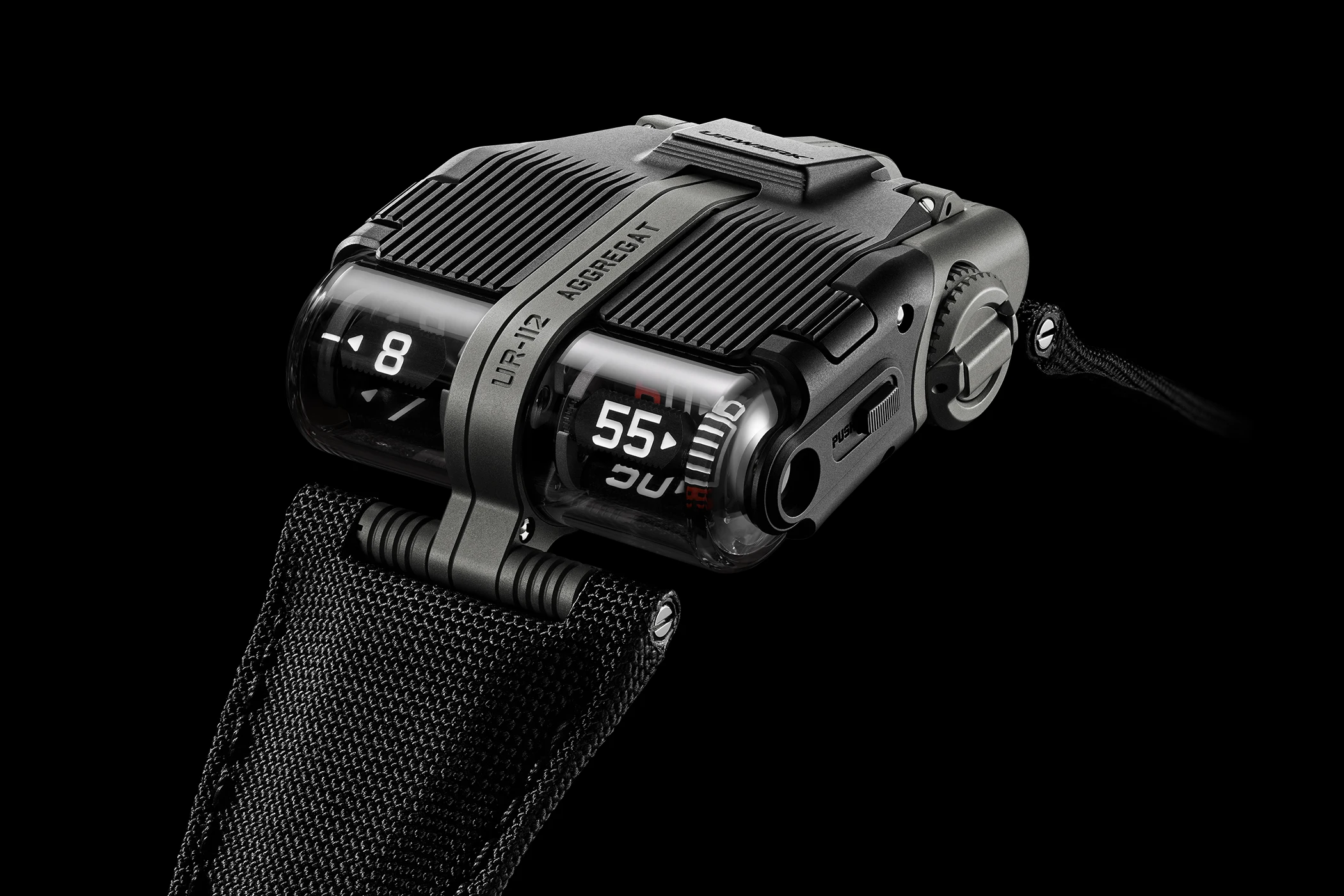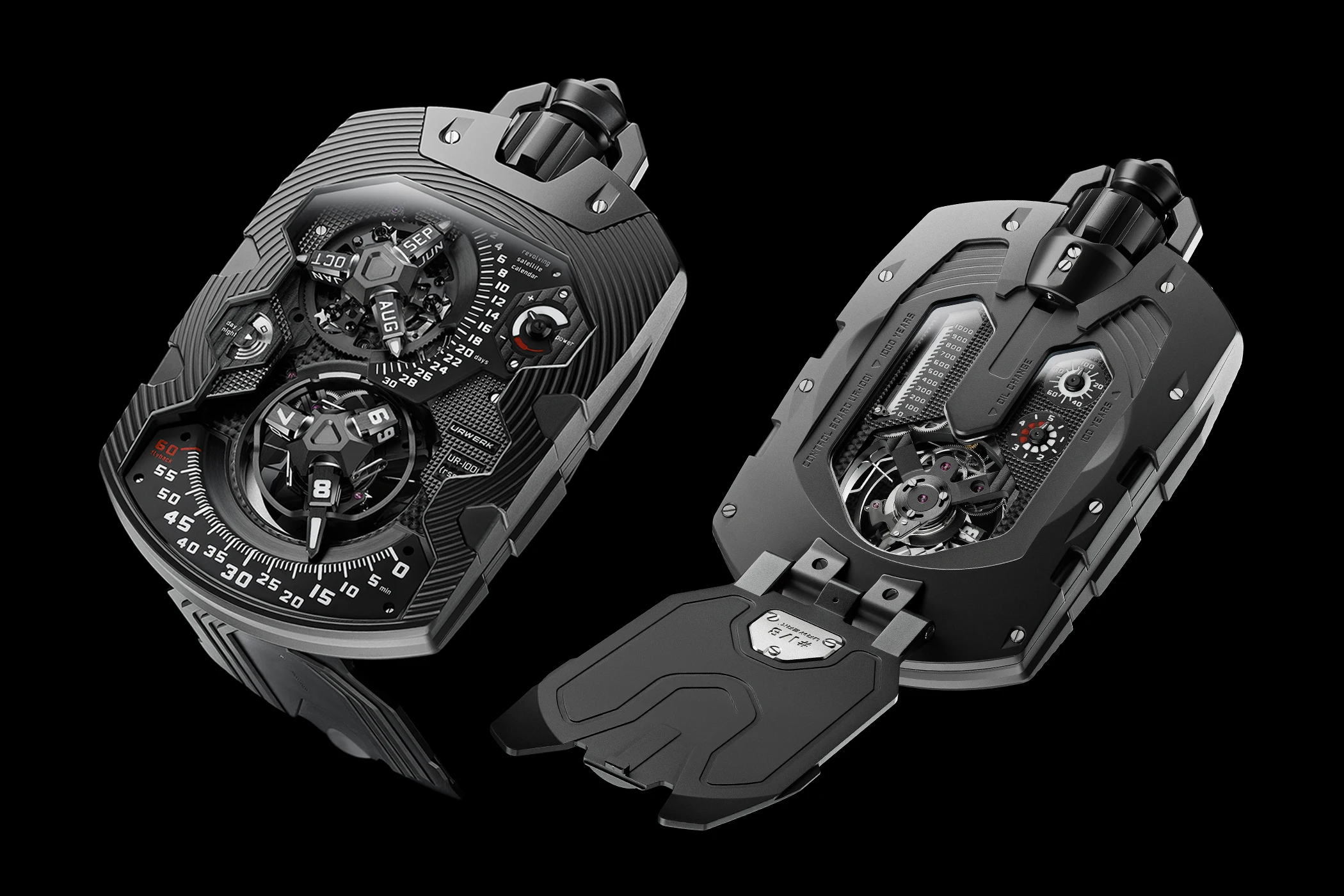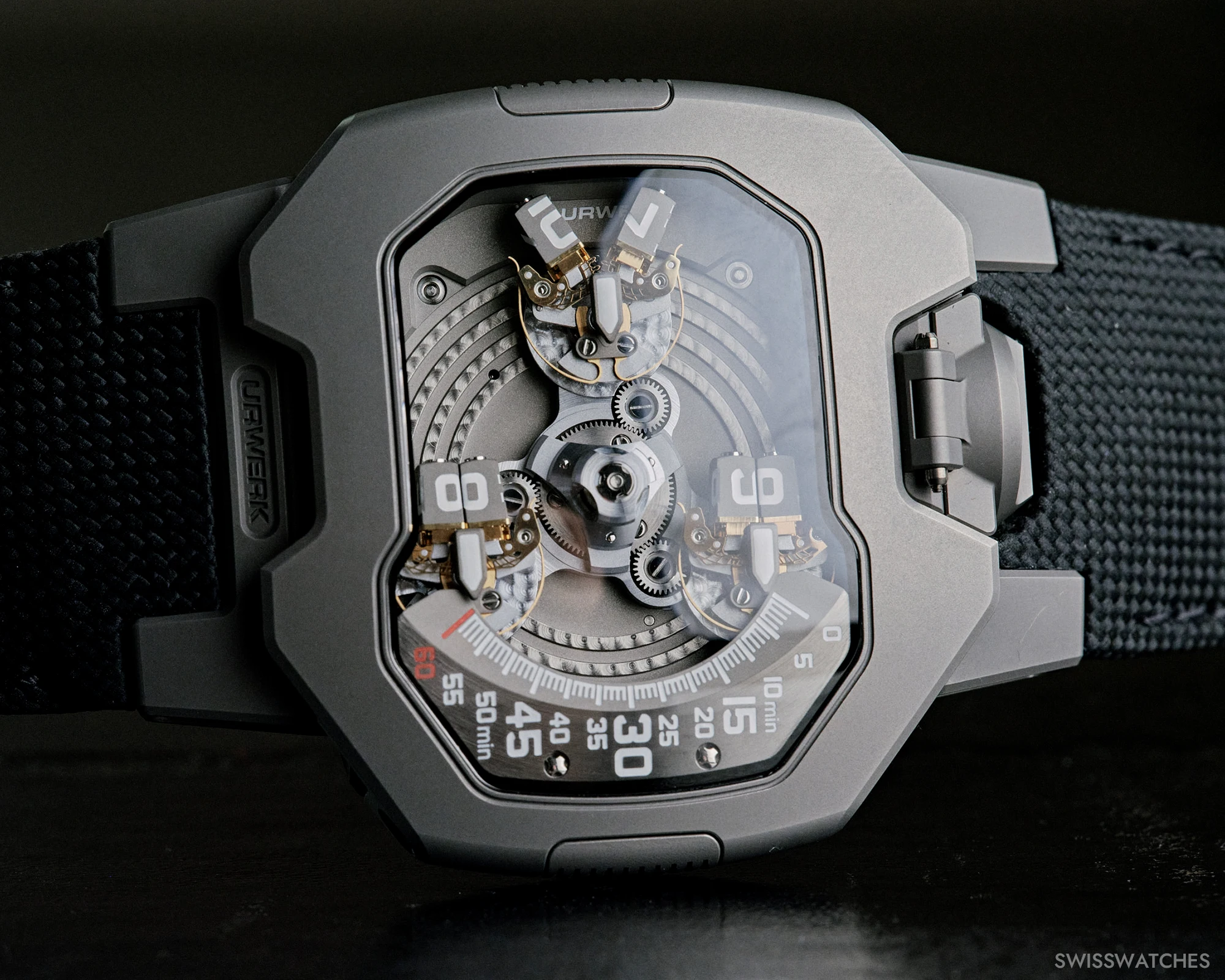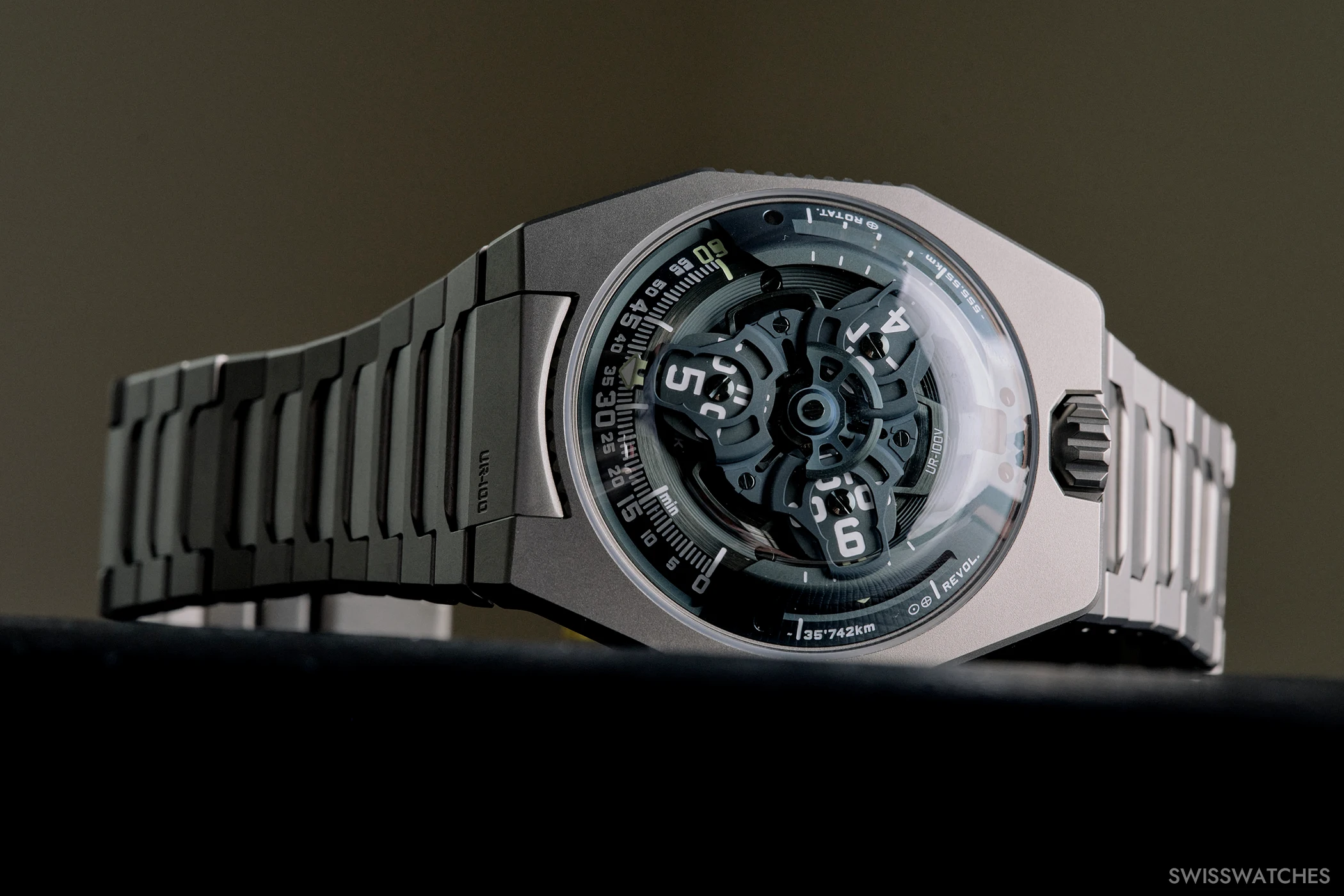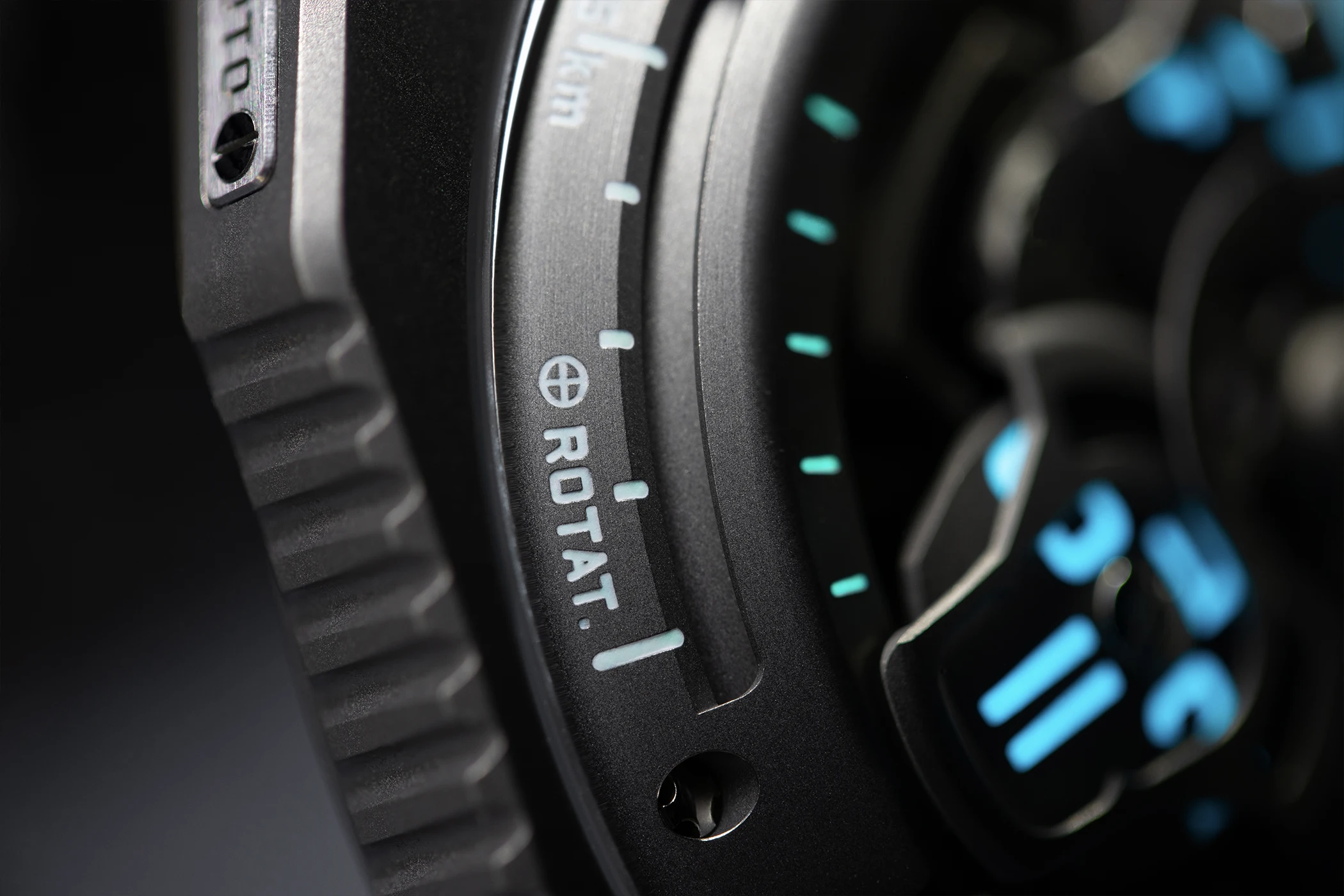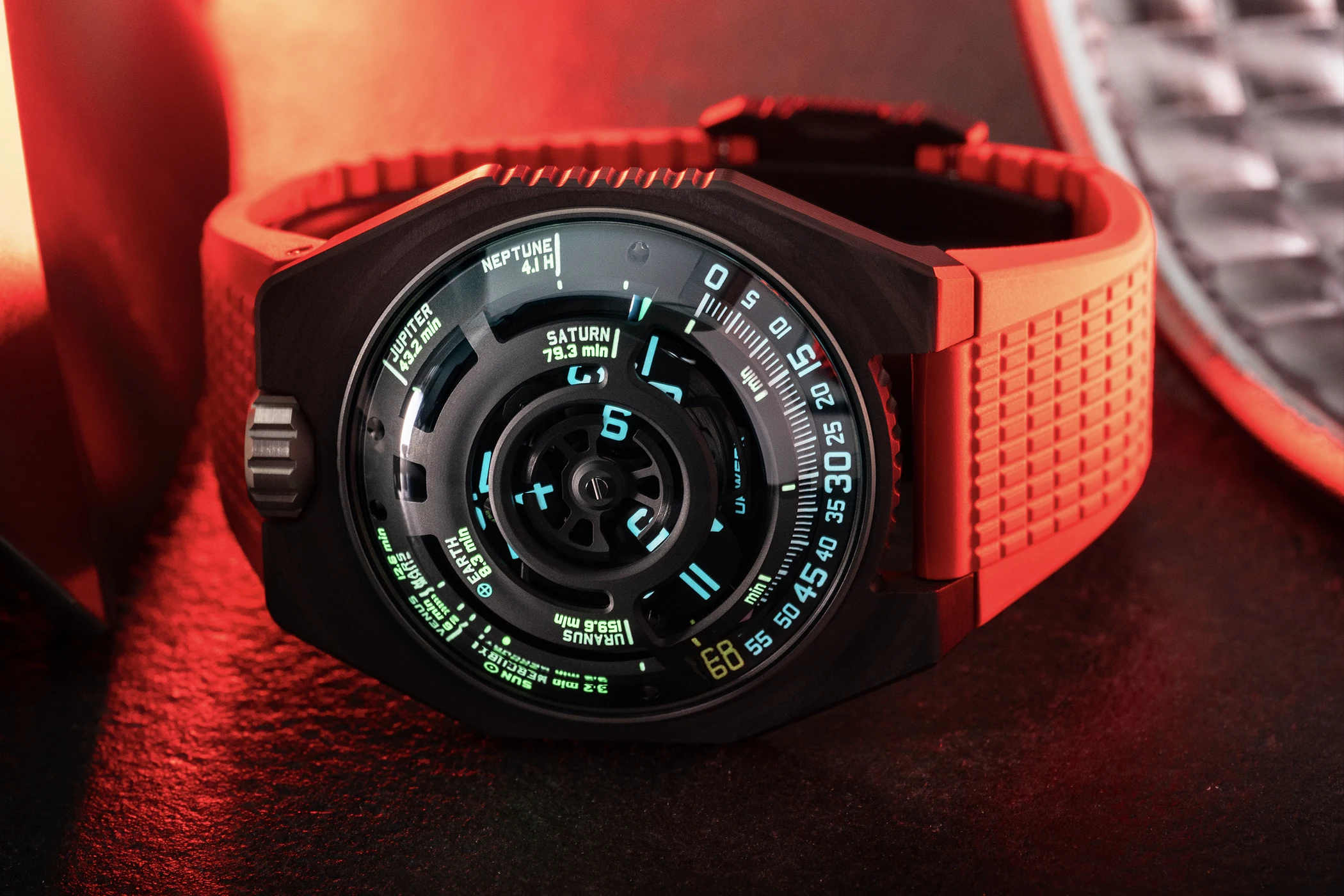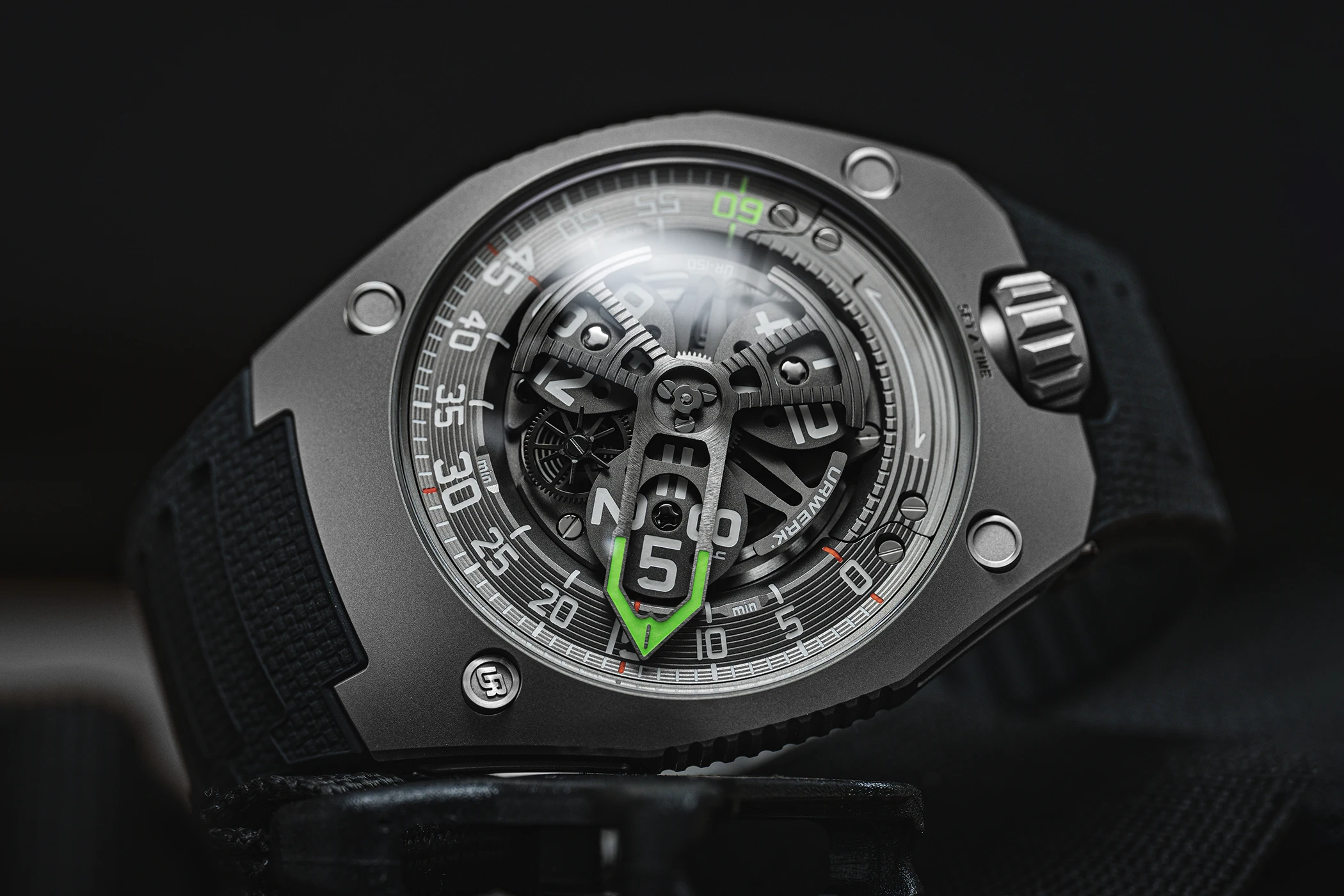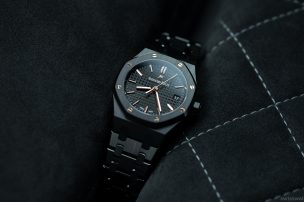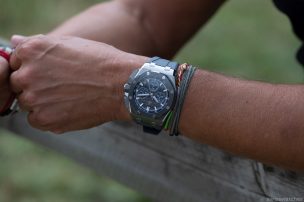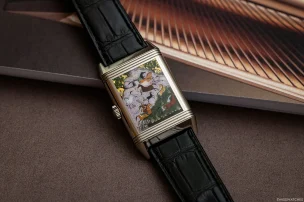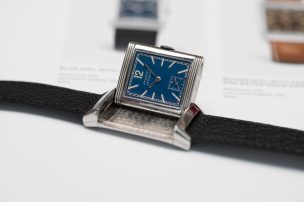
Wempe x Urwerk – Tradition Meets Avant-Garde Technology
On the occasion of the launch event at Wempe in Hamburg, we sat down for an in-depth conversation with the minds behind the watch brand Urwerk, as well as Chiara Wempe and Philipp Steeg.
Watch enthusiasts in search of the extraordinary have always been in good hands with Wempe. The family-owned company has a keen instinct when it comes to choosing its partner brands – always knowing how to both delight and surprise its clientele.
Wempe’s newest brand marks yet another premiere for Germany. Having once been the country’s first authorised retailer for Rolex, the jeweller is now adding Urwerk to its portfolio.
Irreverent, rebellious, eccentric – these are just a few of the words the Swiss watchmaker uses to describe itself. Now available exclusively through Wempe, the brand adds a bold and unconventional flair to the jeweller’s offering. Founded in 1997 by Felix Baumgartner and Martin Frei, Urwerk’s name and philosophy alone conjure up a flurry of associations – all the more so when one actually sees the timepieces.
Yet for all its boldness, Urwerk is also steeped in tradition – curious, open-minded, and always ready to venture into uncharted territory. These are qualities shared by the Wempe family business. With the recent opening of its new Kontorhouse at Stubbenhuk 10 in Hamburg, the company once again demonstrated its future-facing spirit grounded in heritage and craftsmanship. Located in a listed historic building, the site is now home to one of the largest and most advanced watch workshops in Europe, as well as Wempe’s Chronometerwerke Maritim and Visual Marketing.
Just over a kilometre away, at Wempe’s flagship boutique on Hamburg’s Neuer Wall 11, customers can now discover and acquire Urwerk’s singular watch creations. Despite their supposed eccentricity, these timepieces are always about something deeper: long-term relationships – with the watches themselves, but also between Wempe and Urwerk’s founders, Felix Baumgartner and Martin Frei.
This connection dates back roughly a decade, to the Baselworld trade fair, where Philipp Steeg – now Managing Director of Hamburg’s Neuer Wall 11 boutique – first came across the brand. “Since starting my training at Wempe in 2011, I’ve been passionate about watches,” Steeg recalls. “Once I’d familiarised myself with our collection, I began exploring what else was out there. I quickly developed a fascination for independent brands – and Urwerk became my favourite. The designs, the mechanics, and what these timepieces express – I think it’s all simply brilliant and one of a kind.”
Naturally, the branch director has a favourite model: “The UR-100 is my personal highlight, especially the purple version, which reveals a different colour tone depending on the light. I’m also a huge fan of the new UR-101 T-Rex – the bronze case is just stunning.”
Chiara Wempe, who works alongside her brother Scott as co-head of business development, supporting her mother Kim-Eva Wempe in the commercial development of the family business, has also been familiar with the Urwerk brand for some time, having been introduced to it by a friend.
A visit to the brand’s website didn’t just elicit a spontaneous “Wow!” – it also sparked a lasting fascination with the innovative creativity of Felix Baumgartner and Martin Frei. “I’d never seen anything like it,” she recalls. “It was truly something different and deeply impressive. When, like my brother and I, you grow up surrounded by jewellery and watches, you come across an incredible number of brands – but Urwerk really took me by surprise and instantly captivated me. This partnership is the fulfilment of a dream.”
Her favourite Urwerk model, incidentally, reminds her of a Greek proverb: “Society grows when people plant trees under whose shade they know they will never sit.” The saying reflects the importance of foresight and long-term thinking – precisely the spirit captured in the UR-1001. This exceptional timepiece measures time not just by the second, but all the way up to an astronomical millennium, displayed on the back of the watch. The 100-year indicator advances in five-year increments – meaning that wearers will witness its progress multiple times within their lifetime. The 1,000-year display, however, is a different story. Only once the 100-year scale reaches its maximum does the small hand on the “1000 Years” subdial begin its barely perceptible, but relentless movement – progressing in 100-year steps toward the next millennium.
“This watch is built for an entire millennium. It’s such a beautiful concept,” says Chiara Wempe. “It embodies the kind of long-term thinking we also value at Wempe. You know something is moving, but so slowly that it makes you truly grasp the dimension of time – and what time actually means.”
Urwerk x Wempe: A Meeting of Super Partners
The admiration is mutual. Felix Baumgartner describes Wempe – the first jeweller Urwerk is collaborating with in Germany – as the “ideal and trustworthy super partner.”
“Wempe has an incredible tradition spanning nearly 150 years. That includes, among other things, Wempe-Chronometerwerke Maritim with its mechanical marine chronometers, glass clocks and integrated time systems. The company launched its first electronic master and slave clock systems back in the 1970s. That mindset mirrors our own at Urwerk: we unite traditional values and craftsmanship with truly avant-garde technology,” explains Baumgartner. He is also genuinely enthusiastic about the fifth generation of the Wempe family entering the business. “Extremely likeable and open – it’s a real joy to know Chiara and Scott Wempe and to work with them and the entire team.”
In fact, he and Martin Frei are more than happy to hand over the baton from one generation of the watch industry’s ‘young rebels’ to another – especially since the new wave of youthful enthusiasm has already been translated into genuine expertise and high-level client consultation.
“Of course, Urwerk is a brand that takes some getting used to – both for us as a jeweller and for watch enthusiasts,” says Philipp Steeg. “That’s why we’re placing great emphasis on staff training, so we can pass on the compelling stories and the high level of technical complexity to our clients.”
Chiara Wempe adds: “It was a very special moment for me when we presented Urwerk’s timepieces to our team for the first time – and I got to witness their excitement firsthand.”
That said, these timepieces are few and far between: only around 150 to 200 Urwerk watches are produced each year in the brand’s atelier. Wempe now offers six models for a start, all of which are available for viewing at its Hamburg boutique on Neuer Wall 11.
How Urwerk Shook Up the Watch World as One of the Industry’s ‘Young Rebels’
Urwerk was originally conceived as an experiment. But after 28 years, that label hardly applies. What has remained, however, is the sense of unorthodoxy, curiosity, and unrelenting innovation that defined its earliest days. Founders Felix Baumgartner and Martin Frei have preserved this spirit to this day. In fact, one might even argue that Urwerk should always be spoken of in the plural – for each of its two founders contributes a unique perspective: one from the world of watchmaking, the other from the world of art. Together, they have created an entirely new, ticking universe.
In this universe, the past and horological tradition coexist with transgressions and radical visions of what timekeeping can be. “Are there limits?” That is the question Felix Baumgartner and Martin Frei pose in conversation with Swisswatches Magazine to mark the launch of the brand at Wempe – and they answer it themselves, in a manner laced with concepts and anecdotes rarely heard in the context of Swiss haute horlogerie. There is talk of the god of precision, a chicken grill in Dubai, a 1990s Tamagotchi, a hand crank, wandering hours – and more than one moment of shock.
“In 1997, it was of course a shock to present a watch that looked like a UFO – and a brand with a name that wasn’t French,” Baumgartner recalls.
Urwerk: Bridging the Gap Between Tradition and the Future
But how did Felix Baumgartner and Martin Frei find their way into the world of watchmaking in the first place? In Baumgartner’s case, the answer is straightforward.
“I’m the son and grandson of watchmakers,” says Baumgartner, a master of his craft. “The first concert I can remember was performed by the more than 50 antique clocks ticking away in my father’s workshop. I’ve been a watchmaker since birth – and today, I’m one out of passion.”
Legend has it that his very first word was “tick-tock.” But it wasn’t just the ticking of the clocks that made up his daily symphony. “My father’s restoration studio was right next to my bedroom, and I could always hear him speaking to the watches or their components – sometimes it sounded like a proper argument,” he recalls. For Baumgartner, a watch was never merely a tool to measure time – it was something to form a bond with.
After attending the watchmaking school in Solothurn, he worked independently in Geneva, developing complex pieces featuring perpetual calendars and minute repeaters, as well as undertaking restoration work for renowned brands. It was in Geneva that he met Martin Frei – and together, they conceived the dream of creating their own haute horlogerie timepieces. In 1997, their first Urwerk was unveiled at Baselworld.
Frei’s path was quite different. “After studying visual design and art, I was exposed to a wide range of influences and cultures. When I stepped into the world of watchmaking, I brought all of my artistic baggage with me. I never saw my artistic background as a limitation – rather, it opened new horizons in watch design. Technique, concept, and aesthetics are, above all, creative processes.”
As a child, Frei had already come across Rolex. “I remember cutting a picture of a Rolex out of a catalogue and placing it on my wrist. My father also had some great watches – but at the time, I didn’t feel part of that world, nor of the world of technology. Perhaps it was because I wanted to choose a different path to my father, who was an engineer and physicist.”
Instead, he opted to study design and art in Lucerne, founded the artists’ collective U.S.A. – United Swiss Artists – in 1994, and staged exhibitions, videos, and performances. Then, in 1995, came the fateful encounter with Felix Baumgartner – one that led to the founding of a new watch brand. In a country overflowing with timepiece marques, many of which are now being revived, Baumgartner and Frei never considered following that route.
“We really wanted to create something entirely different,” says Frei. “The people behind a brand don’t have to be dead to build beautiful watches,” adds Baumgartner. “In my opinion, it was time to move on from this idea that one had to be deceased in order to be respected in the world of haute horlogerie.”
Urwerk – A Name That Means More Than Just a Play on Words
The name Urwerk is an integral part of the philosophy shared by Felix Baumgartner and Martin Frei. Once again, it reflects how the brand intertwines avant-garde thinking, futuristic design, and the history of time and its measurement.
“In words like Urknall (Big Bang), Ursprung (origin), uralt (ancient), or Urzeit (primeval time), the prefix ‘Ur’ always refers to a beginning,” explains Martin Frei. “Without the ‘h’, Ur also refers to one of the earliest known Sumerian cities. The origins of the city of Ur date back to around 4000 BC.” For Baumgartner and Frei, founding Urwerk was more than a fresh personal start – it was the creation of a completely new kind of watchmaking.
But that’s not the full story. “The Sumerians, who built this city, were deeply engaged with mathematics and the stars. Their cuneiform script – alongside Egyptian hieroglyphs – is the earliest known form of writing. And they also developed a numerical system on which the division of hours and minutes into 60 units is still based today,” Frei continues. It is thought that the Sumerians derived this base-60 system from counting three segments on each of the four fingers – little, ring, middle, and index – giving 12 joints in total, which, when combined with the five digits of the other hand, yields 60.
And what of the second part of the name – Werk? In German, the meaning hardly needs explaining. It refers to work, to creation, to invention and design. For the founders of Urwerk, however, it also stands for something more: the act of stirring emotion.
Wandering Hours and Satellite Displays
“There are so many fascinating and inspiring discoveries to be made when you delve deep into the history of timekeeping,” says Martin Frei. One result of transforming such historical insights into the Urwerk philosophy is the use of wandering hours. Also known as floating hours, this complication has existed for centuries.
In 1656, the Campani brothers built a night clock featuring this system for Pope Alexander XII. As the Pope suffered from insomnia, the numerals were illuminated by an oil lamp so the time could be read in darkness. Instead of hands, hour numerals moved along a semi-circular track on rotating discs. Depending on the position, the passing of a quarter hour or half hour would also be indicated.
Credit © Bonhams
This same principle – minus the oil lamp – forms the foundation of all Urwerk watches. The wandering hours are displayed like satellites orbiting a central axis, gliding across a minute scale as they go. This unique display makes reading the time not only intuitive, but also visually striking and compelling.
Urwerk in Conversation with Swisswatches Magazine
On the occasion of the launch event at Wempe in Hamburg, we took the opportunity to sit down for an in-depth conversation with the minds behind the watch brand Urwerk.
What Parallels Exist Between the Worlds of Horology and Art?
Martin Frei: Art can be anything – including a watch. Like art, it’s about abstract concepts and questions: What is time? What is value? What kind of relationship exists between humans and machines? In that sense, both worlds blend in our timepieces.
Felix Baumgartner: The UR-103 Blackbird, with its blackened platinum case, captures that idea particularly well. It was Martin’s concept – this almost absurd idea of hiding the colour of such a precious material. Two or three years later, brands like Audemars Piguet began working with blackened platinum too. It even became a bit of a trend.
Credit © Christies
Martin Frei: The inspiration came from the art world. A fellow student of mine once painted over one side of 2,000 Swiss francs’ worth of banknotes in white and impaled them into a sculpture. Not only was that technically illegal, it also rendered the banknotes worthless. Yet she sold the piece for a high price – because through her artistic intervention, she had created new value.
On the Subject of Inspiration: Your Watches Have No Predecessors – Where Do Your Ideas Come From?
Martin Frei: If you stay curious and look at the world with open eyes, you’ll find things that inspire and excite you at every turn. I remember a moment in Oman. We were standing in front of a chicken grill, watching the rotating spit – and we thought, what a fascinating mechanism. That became one of the sources of inspiration for the UR-112. Of course, many other elements played a role too, but the spit in Oman was definitely one of them.
Felix Baumgartner: The idea for one of our watches usually feels like a puzzle, assembled from a variety of impressions – things from everyday life and cultural experiences. Sometimes that mix leads to a watch, and sometimes it doesn’t.
Martin Frei: I think by now we’ve accumulated more ideas for watches we haven’t built than ones we’ve actually brought to life. So yes, our idea book is very well stocked for the years to come.
Does It Take Courage to Wear One of Your Watches?
Martin Frei: You do need a bit of courage, yes. But once you have it, you realise that wearing an Urwerk watch changes you – it has an effect. It’s quite remarkable.
Wearing something truly special transforms you. Even an object as small and seemingly ordinary as a watch can do that. At the same time, wearing an Urwerk makes you experience time differently – because it works in a way that contradicts everything we’re visually conditioned to understand from early childhood. That’s why our clientele is such an interesting mix – from biologists to brain surgeons. What they all share is a sense of curiosity and an openness to the extraordinary, even the eccentric.
One of our customers, for instance, is Aki Maita, the creator of the Tamagotchi in the 1990s. That virtual pet game, where players had to care for a digital creature, was all about the relationship between humans and machines – just like with watches, and especially our watches.
Felix Baumgartner: Our timepieces are striking and fairly large, but we place a great deal of importance on wearability. Despite their size, they sit comfortably even on slimmer wrists. We’re trying to move towards slightly more moderate proportions – but our cases are densely packed with mechanics and technology. Not a single millimetre is wasted.
Beyond Design and Mechanics – What Else Sets Urwerk Apart?
Felix Baumgartner: One example is how we’ve broken away from the pricing structures that have long existed in the watch industry – often without any real justification. It’s a bit like cars: whether they have four, six, or twelve cylinders – the twelve-cylinder version is naturally the best and most expensive.
For decades, watchmaking followed a similar logic. A perpetual calendar was allowed to cost CHF 50,000, a tourbillon CHF 100,000, and a minute repeater CHF 200,000. I always found these pricing conventions absurd – so we simply didn’t follow them.
Instead, we’ve created our own mechanisms and complications. These innovations require immense effort – and of course, they come with their own pricing. What we aimed to do was to establish new values and a new aesthetic. For many in the watch world, it was quite a shock that we were deliberately ignoring rules that had stood for decades.
Can You Give an Example?
Felix Baumgartner: With the UR-103, launched in 2003, we positioned the indicators for less frequently used functions on the back of the watch. We were inspired by marine chronometers – which, in hindsight, already hinted at a connection with Wempe and their Chronometerwerke Maritim.
In doing so, we effectively created a new complication. It was as complex to engineer as a perpetual calendar – and that’s why we felt this watch justified a price of CHF 50,000. At the time, this shocked a lot of people. But then sales picked up, journalists became curious, and suddenly even tourbillons were being sold for CHF 50,000. In a way, we helped dismantle the rigid pricing structures that had defined the industry for so long.
You Mentioned the Effort That Goes into Creating a Urwerk Watch. What Does That Involve?
Felix Baumgartner: Since there’s no handbook that outlines all of our mechanisms and functions, the development, construction and testing phases are incredibly intensive – all of that has to be done from scratch before we even reach a first pre-series. That process alone takes anywhere from two to eleven years. And then it usually takes another year before the watch is actually ready for production.
Do You Believe There Are Limits in Watchmaking?
Martin Frei: I believe it’s more a matter of taboos that we seek to break. In haute horlogerie, for example, there’s a deeply rooted fear of electronics. That probably stems from the shock of the 1970s, when quartz watches emerged and mechanical timepieces were pushed aside for many years. The Japanese responded to that shift with far greater openness and ease.
In Switzerland, however, the world of haute horlogerie still largely rejects electronics – it remains a taboo subject. But that doesn’t mean we’re talking about the same quartz technology that once triggered a major crisis in the Swiss watch industry. With the EMC – Electro Mechanical Control – for instance, we’ve developed a concept that integrates electronics into a mechanical watch in a completely new and highly useful way.
Could You Explain That in More Detail?
Martin Frei: It’s the world’s first mechanical precision watch that allows the wearer to measure the chronometric performance of their timepiece themselves. When activated, a tiny optical sensor on the balance wheel records the precise oscillation rate over a period of three seconds. The precision can then be adjusted by turning a screw on the back of the watch.
Felix Baumgartner: I already found the taboo around electronics in watches strange during my training. We defend the Swiss mechanical watch with all our might, designing and crafting it with great care and traditional handwork. Yet in the end, the final quality check is carried out with an electronic device. That’s the standard – the so-called electronic god of precision. So why not miniaturise that god and integrate it directly into the watch? That’s exactly what we did with the EMC.
So the EMC Is Battery-Powered?
Martin Frei: No – because in haute horlogerie, there’s also this great fear of batteries that need to be replaced at regular intervals. We solved that challenge in a rather unconventional way.
The monitoring unit in the EMC is powered by a micro-generator made by the Swiss company Maxon – renowned for developing the motors used in NASA’s Mars rovers. It’s wound by hand using a small crank mounted on the side of the case. The entire project took around six years to complete. We also drew on expertise from a wide range of fields – including support from CERN and the pharmaceutical industry.
That Speaks to Real Perseverance in Your Development Process.
Felix Baumgartner: Even more so with the AMC – the Atomic Mechanical Control – which took eleven years from concept to first pre-series. But then again, we’re talking about two watches. In this case, the precision of an atomic clock is transferred, via a complex mechanical interface, to a mechanical wristwatch. The atomic clock is the most accurate timekeeper in existence – if there’s a god of precision, then it’s even greater than the quartz god.
The idea of one watch transmitting its accuracy to another might seem entirely new – but in fact, it dates back to none other than Abraham-Louis Breguet.
His Sympathique clock No. 666 was paired with a pocket watch that would naturally lose some accuracy throughout the day due to movement and wear. The desk clock, by contrast, remained stationary. Upon returning home, one could “dock” the pocket watch to the more precise desk clock, enabling them to synchronise.
It’s the same principle behind our AMC. So for all our rule-breaking and boundary-pushing, Urwerk remains deeply connected to the rich and fascinating history of traditional watchmaking. That said – for us, even history holds no taboos.
UR-120 Aka Spock
Raise your hand, palm forward, with fingers split in the middle – and then the salute: “Live long and prosper.” This iconic phrase from the science-fiction series Star Trek has adorned a wall in Urwerk’s Geneva workshop for many years. And now it appears above the mainplate of the UR-120 Aka Spock – a timepiece whose display mimics the Vulcan salute. To achieve this, Urwerk reimagined its signature satellite display system from the ground up.
The inspiration lies 16.5 million light years away, in the Beta Quadrant – home to Mr Spock. The result: rotating satellites that spin on their own axis, housed in a flatter case measuring 44 × 47 × 15.8 mm, crafted from titanium and stainless steel. When the blocks that make up each satellite open, they reveal a V-shape reminiscent of the Vulcan gesture. Inside, the automatic calibre UR-20.01 drives the display, with a central satellite carousel fitted with three arms – each carrying a satellite.
“The energy control is both complex and extremely delicate. We have to coordinate both the opening and the rotation of the blocks. In the end, we had to manufacture the specific spring ourselves – it took many experiments to find the right geometry and thickness,” explains Urwerk co-founder and master watchmaker Felix Baumgartner.
UR-100V Magic T Hunter Green
With this piece, Urwerk breathes new life into the minimalist beginnings of the brand, expanding its UR-100V family. “We’re really enjoying this collection and keep rediscovering it through new expressions. Hunter Green felt like a natural choice. It’s a vibrant, breathing colour that interacts with both light and time,” comments Martin Frei, co-founder and artistic director at Urwerk.
In addition to its wandering hour display – featuring no traditional hands – this UR-100V offers two unique indicators: one shows the 555 kilometres the Earth rotates through in 20 minutes on its own axis; the other shows the 35,740 kilometres it travels in that same time in its orbit around the sun.
Thus, the Hunter Green edition transcends horological functionality, becoming a chronicle of Earth’s celestial journey through the vacuum of space. Inside its 41 × 49.7 × 14 mm titanium case ticks the automatic calibre UR-12.02, offering precision and a 48-hour power reserve.
UR-100V LightSpeed
In a time when science fiction and reality increasingly blur, certain numerical constants offer reassurance – immutable, omnipresent, and universal. Among them is the number 299,792.458 – the number of kilometres light travels in a single second. “To wear this creation is to carry a fragment of the universe on your wrist – a miniature cosmos scaled to the human dimension,” says Martin Frei, Urwerk’s co-founder and artistic director.
This UR-100V houses a three-dimensional planetarium, featuring eight celestial bodies from our solar system and eight corresponding reference points. “Starting from the Sun, we calculated and visualised the time it takes a beam of light to reach each of the planets. Sunlight takes 8.3 minutes to reach Earth, and a further 35 minutes to reach Jupiter. It’s a journey through space and time – with light as the medium, the most magical of all vessels,” Frei explains.
Alongside its interstellar storytelling, the UR-100V LightSpeed follows Urwerk’s signature time display without traditional hands. Instead, a satellite moves along an arc: one carries the hour indication, the other the minutes. The watch is powered by the automatic calibre UR-12.02, offering a 48-hour power reserve.
UR-100V Ultraviolet
Violet – the rich hue that marks the very edge of the visible spectrum for the human eye. “I’m fascinated by the idea of creating a watch that celebrates that threshold – that turning point where the visible slips into the invisible,” says Martin Frei, commenting on the colour choice.
Technically, this UR-100V shares the hallmarks of its siblings in the 100 series: the wandering hours and minutes via satellite display. But it also introduces a new layer of information. As soon as the 60th minute is reached, the minute satellite vanishes and reappears as a kilometre indicator – showing the 555 kilometres each person on Earth travels through space every 20 minutes due to Earth’s rotation. In that same time, the planet also covers 35,740 kilometres in its orbit around the sun.
“This creation was inspired by a gift from my father, Geri Baumgartner – a renowned restorer of antique timepieces,” says Felix Baumgartner, Urwerk co-founder and master watchmaker. “It was a watch made by Gustave Sandoz for the 1893 World’s Fair. Instead of hours, it displayed the Earth’s rotational distance at the equator.” Beneath the domed sapphire of the UR-100V Ultraviolet beats the automatic calibre 12.02, housed in a 41 × 49.7 × 14 mm titanium case.
UR-101 T-Rex
Bronze armour, raw presence, primal connection. The revived UR-101 is not content with merely being seen – it wants to be touched. Normally, organic guilloché patterns are confined to dials, protected beneath sapphire glass. Here, however, the texture is deliberately exposed, inviting tactile interaction. The bronze reacts to this contact, oxidising over time and developing a unique patina for each individual watch.
At the heart of the 41 mm case is the automatic calibre UR-1.01V, featuring two satellites, a 180-degree display, and a robust, azuré-finished carousel – a powerful tribute to Urwerk’s founding concept of the wandering hour. It evokes the spirit of the brand’s very first movements.
“Our original idea was a satellite hour display. Building a carousel nearly 150 times heavier than two conventional hands was our first challenge,” recalls Urwerk co-founder and master watchmaker Felix Baumgartner. “Together with Svend Andersen, my first watchmaking mentor, we realised that a Maltese cross would be needed to control the mechanism. And that was only the beginning of the challenges we’ve faced ever since.”
UR-150 Scorpion
For this model, Urwerk has reimagined its signature satellite hours complication – drawing unexpected inspiration from none other than Muhammad Ali. The multiple world champion and heavyweight boxer once famously described the secret of his success: “Float like a butterfly, sting like a bee.”
That sentiment translates effortlessly to this timepiece, which also stings – but like a scorpion. The nickname of this creation refers to its 240-degree minute sector, which resembles the poised, curved tail of a scorpion ready to strike. The symbolism extends to the retrograde minute hand, which unleashes its coiled energy at the end of each hour – fearsomely snapping back to zero.
“To power all the satellites, guide the hour hand, and ensure that each component jumps precisely on cue, we had to develop a new satellite complication system,” explains Urwerk co-founder and master watchmaker Felix Baumgartner. “This new mechanism reads and follows the contours of a cam. So we replaced our classic Maltese cross-based system with this cam and a rack-and-pinion configuration.” Inside the 42.49 × 52.31 × 14.79 mm titanium and stainless steel case – also available with an anthracite-coloured PVD coating – ticks the automatic calibre UR-50.01. It features a double turbine system and a power reserve of 43 hours.
